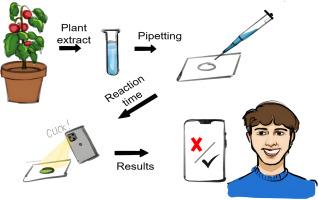基于RNAzymes的纸基微流控装置比色法检测和定量番茄叶片提取物中与应力相关的microRNA408
IF 4.9
2区 化学
Q1 CHEMISTRY, ANALYTICAL
引用次数: 0
摘要
及时发现作物中的应激介质对于防止重大损失和优化农业生产、促进实施符合长期粮食安全的适当管理战略至关重要。MicroRNAs (miRNAs)通过调控基因表达来调控胁迫反应,为了解作物的适应机制提供了新的思路。rnazymes -催化RNA分子-可以定制结合特定的miRNA序列,产生准确的miRNA检测和定量比色信号。利用RNAzymes检测mirna为作物胁迫监测提供了一种有前景的策略。这项工作提出了一种基于混合纸/塑料的装置,用于使用基于rnazyme的比色传感器检测植物中的应激反应介质。结果以番茄植株为模型,设计了针对作物关键胁迫标志物miRNA408的特异性RNA传感探针。在溶液中成功设计RNAzyme传感器后,将传感器转移到蜡环划定的纸张区域。传感探针显示出自己的活性,并且观察到添加miRNA408诱导了颜色信号强度的降低。较高的目标浓度(溶液中0-2560 ng,纸上0-640 ng)导致更强的抑制作用和更弱的比色信号,溶液中的检测限为233 ng(25分钟),纸上的检测限为43 ng(9分钟)。然后将传感器集成到微流控装置中,并在蒸馏水和番茄叶提取物中使用合成miRNA408 (640 ng)进行测试,一旦反应开始,仅在9分钟内就显示出明显的目标抑制作用。这些发现代表了第一个基于rnazyme的作物miRNA检测纸技术,为农民提供了数字化的现场决策工具。结果有助于促进对番茄和其他物种的应激反应机制的理解。本文章由计算机程序翻译,如有差异,请以英文原文为准。

Colorimetric detection and quantification of the stress-associated microRNA408 in tomato leaf extracts through RNAzymes in a paper-based microfluidic device
Background
Timely detection of stress mediators in crops is crucial for preventing significant losses and optimising agricultural production, facilitating implementation of appropriate management strategies aligned with long-term food security. MicroRNAs (miRNAs) regulate stress responses by modulating gene expression, offering insights into crops' adaptive mechanisms. RNAzymes-catalytic RNA molecules-can be tailored to bind specific miRNA sequences, producing a colorimetric signal for accurate miRNA detection and quantification. miRNAs' detection with RNAzymes offers a promising strategy to monitor crop stress. This work presents a hybrid paper/plastic-based device for detecting stress response mediators in plants using RNAzyme-based colorimetric sensors.
Results
Specific RNA Sensing Probes were designed for miRNA408, a key stress marker in crops, using tomato plants as a model. After successful RNAzyme sensor design in solution, the sensor was transferred to a wax-ring-delimited paper area. The Sensing Probes exhibited activity on their own, and it was observed that the addition of miRNA408 induced a decrease in the colour signal intensity. Higher target concentrations (0–2560 ng in solution, 0–640 ng on paper) led to stronger inhibition and weaker colorimetric signals, with detection limits of 233 ng in solution (25 min) and 43 ng on paper (9 min). The sensor was then integrated into a microfluidic device and tested with synthetic miRNA408 (640 ng) both in distilled water and in tomato leaf extract, showing significant target inhibition in just 9 min once the reaction was started.
Significance
These findings represent the first RNAzyme-based paper technology for miRNA detection in crops, offering farmers digital, on-site decision-making tools. Results aid in advancing the understanding of stress response mechanisms in tomato and, potentially, in other species.
求助全文
通过发布文献求助,成功后即可免费获取论文全文。
去求助
来源期刊

Microchemical Journal
化学-分析化学
CiteScore
8.70
自引率
8.30%
发文量
1131
审稿时长
1.9 months
期刊介绍:
The Microchemical Journal is a peer reviewed journal devoted to all aspects and phases of analytical chemistry and chemical analysis. The Microchemical Journal publishes articles which are at the forefront of modern analytical chemistry and cover innovations in the techniques to the finest possible limits. This includes fundamental aspects, instrumentation, new developments, innovative and novel methods and applications including environmental and clinical field.
Traditional classical analytical methods such as spectrophotometry and titrimetry as well as established instrumentation methods such as flame and graphite furnace atomic absorption spectrometry, gas chromatography, and modified glassy or carbon electrode electrochemical methods will be considered, provided they show significant improvements and novelty compared to the established methods.
 求助内容:
求助内容: 应助结果提醒方式:
应助结果提醒方式:


